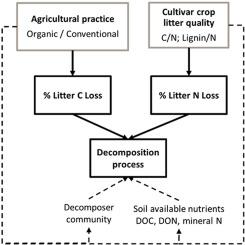Soil Biology and Biochemistry ( IF 9.8 ) Pub Date : 2020-12-21 , DOI: 10.1016/j.soilbio.2020.108115 L.B. Martínez-García , G.W. Korthals , L. Brussaard , G. Mainardi , G.B. De Deyn

|
Litter decomposition and nutrient mineralization are crucial in agricultural systems to maintain soil fertility and plant growth. Given that these processes are governed by soil microbial activity, agricultural management that affects soil microbial communities may significantly alter rates of decomposition and N release of the same litter. We hypothesized that organic compared to conventional management enhances litter decomposition and litter N release, and that this effect is stronger for litter of low quality (high C:N ratio).
We tested these hypotheses using litter from 4 maize cultivars with varying initial litter quality (different C:N ratios and lignocellulose index). These litters were left to decompose in soil with different management history, yet in the same experimental field site. The field experiment consisted of randomized plots with 11 years of organic or conventional agricultural management (organic vs. mineral fertilization). During the 11 years, in year 3 and 4, two specific organic amendments were applied as soil health treatments (SHT: chitin or compost, and a control without SHT). The maize litter was contained in litter bags, buried in the top 10–15 cm soil and collected after 1, 2 and 3 months. We quantified the litter carbon (C) and nitrogen (N) loss, and soil dissolved organic carbon (DOC), mineral and dissolved organic nitrogen (DON) at each sampling time. We also determined the fungal biomass in the decomposing litter after 3 months of decomposition.
Litter C loss was higher in soil under organic compared to conventional management, irrespective of litter quality. In contrast, the rate of N release from the litter was determined by initial litter quality (higher N release from low C:N litter) and not by agricultural management. In soil under organic management the concentrations of DOC, mineral N and DON were larger than in conventional managed soil, which may have stimulated microbial activity and therefore, litter decomposition. Fungal biomass in the decomposing litter negatively correlated with the amount of N in the decomposing litter, but was not affected by management system or litter cultivar.
Overall, we found that in agroecosystems initial litter quality (C:N) is a main driver of litter N release, whereas soil management is a main driver of decomposing litter C loss. Our results show the importance of integrating both litter quality and soil management to enhance our understanding of litter decomposition and N release, and to harness the ecosystem services provided by crop litter in agricultural fields.
中文翻译:

凋落物的质量驱动氮的释放,而农业管理(有机与常规)则驱动着农业生态系统中凋落物分解过程中的碳损失。
凋落物分解和养分矿化在农业系统中对于维持土壤肥力和植物生长至关重要。鉴于这些过程受土壤微生物活动的支配,影响土壤微生物群落的农业经营可能会显着改变同一垃圾的分解和氮素释放速率。我们假设与常规管理相比,有机肥可提高凋落物的分解和凋落物N的释放,并且对于低质量(高C:N比)的凋落物,这种效果更强。
我们使用来自4个玉米品种的垫料测试了这些假设,这些垫料具有不同的初始垫料质量(不同的C:N比和木质纤维素指数)。这些垃圾在具有不同管理历史的土壤中分解,但仍在同一实验田地中分解。田间试验由11年的有机或常规农业管理(有机肥料与矿物肥料)随机分配。在第3年和第4年的11年中,使用了两种特定的有机改良剂作为土壤健康治疗剂(SHT:几丁质或堆肥,以及不含SHT的对照)。玉米垫料装在垫料袋中,埋在10-15厘米的土壤中,并在1、2和3个月后收集。我们量化了凋落物碳(C)和氮(N)的损失以及土壤溶解的有机碳(DOC)的数量,在每个采样时间采集矿物质和溶解有机氮(DON)。我们还确定了分解3个月后分解垃圾中的真菌生物量。
与传统管理相比,有机土壤中的凋落物C损失更高,无论其质量如何。相反,从垫料中释放出来的氮的速率取决于最初的垫料质量(从较低的C:N垫料中释放出更高的氮),而不是由农业管理决定。在有机管理下的土壤中,DOC,矿物质N和DON的浓度高于常规管理下的土壤,这可能刺激了微生物的活动,因此刺激了凋落物的分解。分解垃圾中的真菌生物量与分解垃圾中的氮含量呈负相关,但不受管理系统或垃圾品种的影响。
总体而言,我们发现在农业生态系统中,初始凋落物质量(C:N)是凋落物N释放的主要驱动力,而土壤管理是分解凋落物C损失的主要驱动力。我们的结果表明,必须将垃圾质量与土壤管理相结合,以增进我们对垃圾分解和氮素释放的了解,并利用农田中农作物垃圾提供的生态系统服务。











































 京公网安备 11010802027423号
京公网安备 11010802027423号